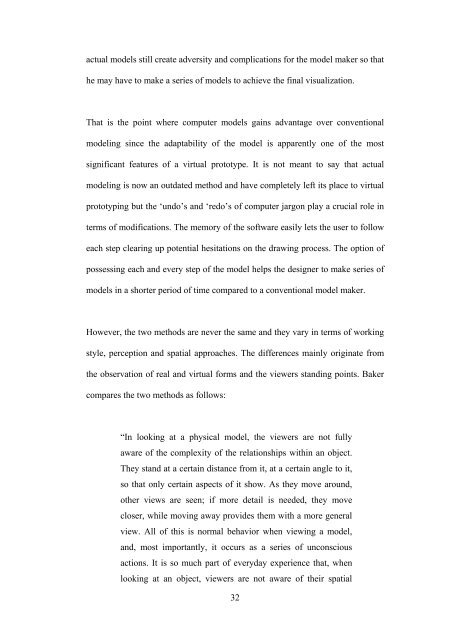virtualization of design and production a thesis - Bilkent University
virtualization of design and production a thesis - Bilkent University
virtualization of design and production a thesis - Bilkent University
You also want an ePaper? Increase the reach of your titles
YUMPU automatically turns print PDFs into web optimized ePapers that Google loves.
actual models still create adversity <strong>and</strong> complications for the model maker so that<br />
he may have to make a series <strong>of</strong> models to achieve the final visualization.<br />
That is the point where computer models gains advantage over conventional<br />
modeling since the adaptability <strong>of</strong> the model is apparently one <strong>of</strong> the most<br />
significant features <strong>of</strong> a virtual prototype. It is not meant to say that actual<br />
modeling is now an outdated method <strong>and</strong> have completely left its place to virtual<br />
prototyping but the ‘undo’s <strong>and</strong> ‘redo’s <strong>of</strong> computer jargon play a crucial role in<br />
terms <strong>of</strong> modifications. The memory <strong>of</strong> the s<strong>of</strong>tware easily lets the user to follow<br />
each step clearing up potential hesitations on the drawing process. The option <strong>of</strong><br />
possessing each <strong>and</strong> every step <strong>of</strong> the model helps the <strong>design</strong>er to make series <strong>of</strong><br />
models in a shorter period <strong>of</strong> time compared to a conventional model maker.<br />
However, the two methods are never the same <strong>and</strong> they vary in terms <strong>of</strong> working<br />
style, perception <strong>and</strong> spatial approaches. The differences mainly originate from<br />
the observation <strong>of</strong> real <strong>and</strong> virtual forms <strong>and</strong> the viewers st<strong>and</strong>ing points. Baker<br />
compares the two methods as follows:<br />
“In looking at a physical model, the viewers are not fully<br />
aware <strong>of</strong> the complexity <strong>of</strong> the relationships within an object.<br />
They st<strong>and</strong> at a certain distance from it, at a certain angle to it,<br />
so that only certain aspects <strong>of</strong> it show. As they move around,<br />
other views are seen; if more detail is needed, they move<br />
closer, while moving away provides them with a more general<br />
view. All <strong>of</strong> this is normal behavior when viewing a model,<br />
<strong>and</strong>, most importantly, it occurs as a series <strong>of</strong> unconscious<br />
actions. It is so much part <strong>of</strong> everyday experience that, when<br />
looking at an object, viewers are not aware <strong>of</strong> their spatial<br />
32
















